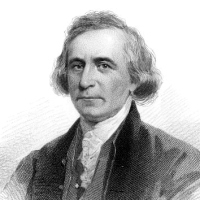The Indian Burying Ground: Philip Morin Freneau - Summary and Critical Analysis
The Indian Burying Ground is a romantic poem by Philip Morin Freneau that imaginatively analyzes the Native American’s rite of burying the dead in a standing (active) posture as a meaningful act that symbolizes the continued existence of their spirit and influence among the living. The speaker is at one of the burying grounds of the native tribes, thinking over the Indian rite of burying the dead in an upright position.

Philip Morin Freneau (1752-1832)
The visitor of the Indian graveyard meditates upon the burying rites of the native Indian peoples; the primitivistic speaker is in the guise of a common man but he is challenging civilized burial customs of the Europeans. He says: "In spite of all that the learned have said / I still my opinion keep". This suggests that the speaker is refusing to accept what the so-called learned people say; he rejects rationalism in favor of mysticism. When civilized culture demands burying a corpse in a prone (sleeping) position, death is seen as an eternal 'sleep' for the soul. The speaker goes on to argue, his imagination becoming more active.
If readers consider antiquity of the American world, they contemplate America’s primordial race of Indians, whose sitting posture in their graves suggests that their soul actively continues the simple pursuit of their former mortal lives as also depicted on their pottery and as indicated by their weapons. For example, an Indian arrow head or “head of stone”, symbolizes the opposite of a European headstone (tombstone), namely, the enduring vitality of the dead person’s spirit unlike the cold, engraved memorial for a dead white man.
The title of the poem "The Indian Burying Ground" is American in the sense it describes the American Indians tradition in burying a dead body. When Indians die they bury them in sitting position; they think that the dead are with life, in their own world. The poem is in ten regular stanzas with the rhyming scheme abab. The first half of the poem describes what happens in the burial ground and second half of the poem describes how to treat on burial ground. Poet, here, in fact is suggesting Americans not to ignore Indian burial. The learned Christian is more pedantic, and the learned Indian is more open. Poet sides with the Indians from the outset of the poem.
A new dimension of looking at life is introduced here. The posture we keep to our dead determines how we look at life after death. Death is not end but it is a release for life is seen as bondage. Choosing a typical American topic here Freneau is successful to create American flavor. American Indians believe in life as lasting or existing forever it is an ad infinitum process. The activities of man, in Indian concept, continue even after death. So dead are buried in a sitting posture and they are supposed to share “joyous feast’ with the friends. The Indian concept of life after death is quite different from Christian concept that believes in an annual of earthly activities after death. The image of bird and painted bowl in the third stanza suggest the restless life of Indians after death; whereas, image of the bow and arrow shows remain of ideas after death. The poet has requested Americans who are quite unknown to the tradition to remain quiet and commit “no fraud upon the death”.
Last few stanzas of the poem give a glimpse of the hunting nature of Indians. The attachment of the Indians with the forest is still the same as it was earlier. Poet, here, has tried to convey a message that the culture of American Indians is as significant as the culture of Christians. All the cultures do have significance in the world. And instead of frowning at something different, we should acknowledge the diversity- in people, in customs, in language, religion and culture.
Cite this Page!
Sharma, K.N. "The Indian Burying Ground: Philip Morin Freneau - Summary and Critical Analysis." BachelorandMaster, 16 Nov. 2013, bachelorandmaster.com/britishandamericanpoetry/the-indian-burying-ground.html.
